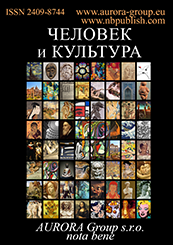Fine arts
Reference:
Reutova , E.M. (2025). Problems of identification and attribution of Italian paintings of the XVI-XVIII centuries on the example of works from the collection of the Omsk Regional Museum of Fine Arts named after M. A. Vrubel. Man and Culture, 2, 1–15. https://doi.org/10.25136/2409-8744.2025.2.73442
Abstract:
The study and attribution of works of fine art remains one of the most important activities of modern art museums. This task is particularly relevant for regional museums, whose collections were formed in the 20th century due to transfers from the State Museum Fund and the capital's state collections. Attribution of works not only allows establishing authorship, but also provides an opportunity to reach the level of deeper generalizations, fills in existing gaps in the history of art, and finally leads to an understanding of the general laws of artistic development. The article highlights some of the research experience of recent years of Italian paintings of the XVI–XVIII centuries from the collection of the Omsk Regional Museum of Fine Arts named after M. A. Vrubel. Attribution was carried out on the basis of an integrated approach involving the use of comparative stylistic analysis, technical and technological research, as well as work with archival documents. The works of Soviet art historians B. R. Vipper, V. N. Lazarev, as well as publications by leading Russian specialists I. V. Linnik, V. E. Markova, I. S. Artemyeva, and others were of methodological importance. The study showed that the focus of the study of Italian painting is not only on the issue of establishing authorship, but also on the problem of identification itself – establishing affiliation to a national school, identifying original works, identifying copies and imitations. In the course of the research, previously accepted attributions were revised, and individual works that were considered nameless acquired the author's name. The introduction into scientific circulation of previously unknown works by Italian masters of the XVI–XVIII centuries from the collection of one of the largest regional museums, as well as the identification of new paintings by artists significant for the history of Western European art, enriches the picture of Italian painting, which determines the novelty of the study. In addition, the obtained data from technical and technological research can serve as comparative material in the study and proof of attribution of works of Western European painting.
Keywords:
artist, collection, technical and technological research, stylistic analysis, national school, Italian painting, attribution, museum, copy, State Museum Fund
Cultural heritage, tradition and innovation
Reference:
Lakhtionova, E.S. (2025). The role of A. S. Terekhin in identifying monuments of industrial heritage of the Perm region in the 1960-1970s. Man and Culture, 2, 16–27. https://doi.org/10.25136/2409-8744.2025.2.73512
Abstract:
The object of the study is Alexander Sergeevich Terekhin, a researcher of the architecture of the Kama region. The subject is his activities in the field of protection of historical and cultural monuments in the 1960-1970s. The purpose of the article is to characterize the role and contribution of the researcher in the process of identifying monuments of the industrial heritage of the Perm region in the specified chronological period. The relevance of the stated topic is that at present it is very important to consolidate all available forces in order to preserve the remaining monuments of the domestic industrial heritage. There are no studies on this topic, which determines the scientific novelty of the study. As part of the preparation of the article, archival materials were used from the Perm State Archive of Socio-Political History and the State Archive of the Perm Territory. In the latter, the personal fund of A. S. Terekhin is most important. The research methodology is presented by general scientific methods, as well as special historical ones: chronological, historical-genetic and historical-comparative methods. The author came to the conclusion that the activities of A. S. Terekhin in identifying monuments of industrial heritage were very effective. In the 1960s - early 1970s. with his active participation, a field survey and study of a number of monuments of industrial wooden architecture, as well as factories and dams in the Perm region, was carried out. As a result of the activities of A. S. Terekhin, a number of industrial heritage objects were put on state registration as monuments of local significance. And some of the objects have undergone museumification within the framework of the Architectural and Ethnographic Museum “Khokhlovka” and the “Museum of Salt of Russia”.
Keywords:
Khokhlovka, ethnographic museum, industrial architecture, wooden architecture, identification, Perm region, A. S. Terekhin, monument, industrial heritage, factories
Cultural heritage, tradition and innovation
Reference:
Lebedeva, N.I., Zhouk, A.E. (2025). Evgeny Alexandrovich Zhuk - the author of the stele of the memorial dedicated to the sailors of the Red Banner Ladoga Flotilla and the river workers of the North-Western River Shipping Company. Man and Culture, 2, 28–39. https://doi.org/10.25136/2409-8744.2025.2.73142
Abstract:
This article is devoted to the history of creation of the memorial monument dedicated to the Red Banner Ladoga Flotilla and rivermen of the Northwestern River Steamship Line in Novaya Ladoga. The article provides a comprehensive study of the architectural and designer project of E. A Zhuk and it's implementation in 1985. The methodology of the research is based on the historical-chronological, structural-functional, and semiotic approaches. Based on the historical and cultural analysis of the dynamics of creation of the monument, the article distinguishes a few innovative techniques and functions fulfilled by the monument, such as: representative; memorial, recording the remarkable achievements of the team of authors and contractors; artistic, within the ensemble perception of the object. The article shows the improvement of the project in the process of working on it. It also illustrates the design solutions, embodied in the construction. Texts and documents contemporary to the architectural idea and it's implementation are analysed. Based on the conducted study, it's concluded that the memorial represents an object perfect in function and artistic image, reflecting the synthesis of innovative techniques, accounting for the specifics of the landscape, and communicating the author's cultural experience. The relevance of the topic is related to its characteristics that are unique to the world's practice of military memorabilia. The scientific novelty of the research is in the attribution of the monument which embodies the patriotic idea of protection of one's Motherland in combination with a memorable artistic image. The monument reflects the socio-cultural code of Leningrad and the region. This indicates that the architect E.A. Zhuk belonged to the Leningrad school, which is characterized by a set of aesthetic views that are inherent in Leningraders.
Keywords:
Flotilla, Ladoga, to the Red Banner, To the sailors, memorial monument, Zhuk, Evgeniy, architecture, design, landscape
Music and music culture
Reference:
Shi, J. (2025). Aesthetic characteristics of twentieth-century Chinese women's music. Man and Culture, 2, 40–50. https://doi.org/10.25136/2409-8744.2025.2.73581
Abstract:
Chinese women's music, as a branch of China's traditional musical culture, has shaped its aesthetic characteristics in close relationship with gender culture, social ethics, and power structures. The evolution of the aesthetic characteristics of Chinese women's music is essentially a story of the interaction of gender discourse and musical semiotics. This cultural practice reflects both the social power structures of specific historical periods and the agency of women in artistic creation. The aesthetic characteristics of Chinese women's music show dual tension: on the one hand, formal norms are formed under the influence of Confucian ethical discipline, characterized by the principle of "Yin gentleness"; on the other hand, through technological innovations and the awakening of subjectivity, a stable expression develops in the intervals of the ritual system. From the individual narrative of the musical and poetic works of Yuefu of the Han era (112 BC) to the artistic self-awareness of the court musical institutions (jiaofang) of the Tang era (618-907), this process culminated in the 20th century with the modern transformation from a "ritual instrument" to an "artistic instrument." The article consists of four parts: the first part is devoted to the basic concepts of women's music. The second part is devoted to the aesthetics of women's music in the system of rituals and music. The third part is devoted to the aesthetic construction of women's music of the XX century. The fourth part is devoted to the duality of aesthetic characteristics of Chinese women's music. In conclusion, the author considers that the transformation of the aesthetic qualities of women's music represents not only a renewal of the artistic form, but also acoustic evidence of the transformation of gender power relations in Chinese society, offering a unique aesthetic dimension for understanding the modernization of traditional culture.
Keywords:
culture, China, musical anthropology, aesthetic construction, gender culture, aesthetic characteristics, music, Chinese culture, women's music, female
Culture and cultures
Reference:
Kadier, A., Tursun, H. (2025). Local Ecological Knowledge from an Anthropological Perspective: An Ethnographic Investigation Based on the Lopliks. Man and Culture, 2, 51–67. https://doi.org/10.25136/2409-8744.2025.2.73184
Abstract:
Since the concept of "local knowledge" proposed by Clifford Geertz was introduced into ecological anthropology and cultural anthropology, local ecological knowledge has remained a hot research topic. The Lopliks have long lived on the desert fringe of the extremely arid Lop Nur region in the southeastern part of the Tarim Basin, Xinjiang, China. Based on their adaptation to the harsh ecological environment, they have developed a rich and effective local ecological knowledge system. This paper aims to explore the traditional local ecological knowledge of the Lopliks,mainly focusing on the economic and cultural foundations, main content, types, and the underlying cultural logic of the local ecological knowledge of the Lopliks. This article primarily employs qualitative research methods, specifically adopting anthropological fieldwork, delving into the living environments of the subjects, and obtaining a large amount of firsthand data through in-depth interviews, participant observation, and other means, laying an important foundation for the analysis presented in the article. The traditional ecological knowledge system of the Lopliks is built upon their cognition of the surrounding ecosystem. These local knowledge and cognitive schemas are integrated with their diverse religious beliefs, cosmology, and cultural customs, fully demonstrating their strong vitality and cultural rationality in adapting to specific ecological environments and protecting the ecosystem. By examining local values, belief systems, social structures, and ritual traditions, anthropology provides unique insights into the interplay between culture and the environment. This allows us to uncover the ecological wisdom, significance, and value embedded within local cultures, and identifying the root causes of environmental problems and potential solutions derived from the local cultural context.
Keywords:
multifaceted economy, local knowledge, folk beliefes, ecological consciousness, adaptation, the Lop Nur Region, anthropology, ecological environment, the Lopliks, taboo
History of art
Reference:
Chen, K. (2025). Comparative analysis of Jesuit architecture of the XVI-XVIII centuries in Asia. Man and Culture, 2, 68–80. https://doi.org/10.25136/2409-8744.2025.2.73712
Abstract:
The article is devoted to a comparative analysis of the Jesuit architecture of the XVI–XVIII centuries in three key Asian regions – Japan, Goa and Macau. The study examines the influence of the European architectural tradition based on the "Instructions" of Carlo Borromeo and the principles of the Jesuit Baroque on the development of religious buildings in conditions of socio-cultural and geopolitical diversity. The novelty of the work lies in the comparative analysis of the Jesuit architecture of Japan, Goa and Macau, which allows us to identify patterns of synthesis of the European Baroque tradition with local construction practices. The general patterns and differences in architectural solutions are revealed due to the level of colonial control, political restrictions and interaction with local building traditions. It is shown that in Japan, the Jesuits were forced to adapt their architecture to local conditions as much as possible, creating portable modular temples, whereas in Goa their architecture almost completely followed European canons. Macau has developed a unique synthesis of Chinese and European architectural traditions, which is reflected in a special combination of Baroque forms and oriental decorative elements. The results obtained allow for a deeper understanding of the mechanisms of intercultural interaction and adaptation of the European architectural heritage in Asia. The research is based on an interdisciplinary approach combining historical and architectural analysis, comparative typological method and elements of a cultural approach. The paper analyzes primary and secondary sources, including written testimonies of Jesuit missionaries, historical chronicles, as well as preserved architectural monuments. The novelty of the research lies in a comprehensive comparative analysis of Jesuit architecture in three different cultural and historical contexts, which makes it possible to identify patterns of adaptation of European architectural traditions to Asian conditions. Unlike most works examining the architecture of the Jesuits in colonial America and Europe, this study focuses on the mechanisms of synthesis of Baroque architecture with local traditions in Asia. For the first time, one study conducted a detailed comparison of the Japanese, Goan, and Macau architectural experiences and showed how the level of political autonomy of the region, economic support for missions, and the attitude of local authorities to Catholic expansion determined the nature of the adaptation of architectural forms. And also analyze and give examples one by one according to the situation in different regions.
Keywords:
colonial architecture, The Catholic Church, architectural syncretism, missionary activity, Japan, Goa, Macau, The Baroque, Jesuit architecture, The Jesuits
Scenic arts
Reference:
Shkliarskaia, A.E. (2025). Virtual reality and the representation of corporeality in contemporary theater. Man and Culture, 2, 81–87. https://doi.org/10.25136/2409-8744.2025.2.73945
Abstract:
The subject of the study is the impact of virtual reality (VR) on theatrical practice, the embodiment of the actor and the audience in the context of digital technologies in theater in the 21st century. Virtual reality (VR) opens up new perspectives for studying embodiment, and modern technologies allow us to rethink the boundaries between the embodiment of the actor, the viewer, and the digital space. This article analyzes the influence of VR on theatrical practice and discusses the main philosophical approaches to the concept of embodiment. Particular attention is paid to the phenomenon of the "virtual body," the concept of bodily extension, and the impact of digital reality on the perception of the human body. Examples of theatrical productions that use VR technologies are examined, including performances "The Cage with Parrots" (Gogol Center), "In Search of the Author" (Tyumen Drama Theater), "I Killed the Tsar" (Theater of Nations), and "Biomechanics VR" (New Stage of the Alexandrinsky Theater named after V. E. Meyerhold). The research method includes an analysis of philosophical approaches to the concept of embodiment and the study of examples of theatrical productions utilizing VR technologies. The research methodology entails qualitative analysis based on the interpretation of theatrical practices and their impact on the perception of embodiment. The novelty of the research lies in a comprehensive examination of the phenomenon of the "virtual body" and the concept of bodily extension in the context of virtual reality in theater. The study covers the intersection of technology and art, emphasizing the significance of VR as a tool for transforming the perceptions of artists, performers, and audiences of stage productions. The findings of the research show that virtual reality not only expands the possibilities of theatrical art but also changes traditional notions of embodiment and interaction in theater. The implementation of VR technologies creates unique spaces for interaction between the actor and the audience, opening new horizons for theatrical creativity. The study also analyzes the impact of VR on the emotional and psychological perception of viewers, offering new approaches for creating immersive theatrical productions.
Keywords:
audience communication, antropological technologies, vr-technologies, immersive, contemporary technologies, vr-performance, digital anthropology, theatre, corporality, virtual reality
Arts and crafts
Reference:
WANG, L. (2025). Installation in contemporary Chinese art. Man and Culture, 2, 88–97. https://doi.org/10.25136/2409-8744.2025.2.73229
Abstract:
The subject of the study is the peculiarities of Chinese installation at its current stage. The object of the research is installation compositions made by Chinese artists. The author examines in detail such aspects of the topic as national specifics, the main themes and typical artistic materials of the Chinese installation. Special attention is paid to the factors that influenced the formation of this artistic trend in China. The importance of the impact of the Western artistic experience is emphasized. Iconic examples of works by Chinese artists and the main trends that stand out in Chinese installations today are considered. The specifics of the female and ecological installation are investigated as well as the interaction of elements of traditional culture and innovative technologies in the installation compositions. The role that installation art plays in shaping China's international image is also mentioned. In the framework of this research, the following methods were used: historical and comparative, as well as critical analysis. The scientific novelty of this study lies in the fact that the author identified the specifics of the Chinese installation, as well as identified the factors that influenced the formation of this specificity. The main conclusions of the study are: despite the significant contribution that the study of foreign experience has made to the formation of installation art in China, modern works by Chinese artists are independent and distinctive. This is achieved through experimentation with traditional cultural objects in the process of creating compositions, as well as artists' reflection on the historical and social experience of China. The modern Chinese installation combines both the use of high technologies and the disclosure of pressing issues for modern Chinese society, as well as close attention to the country's centuries-old cultural heritage.
Keywords:
women's installation, ecological installation, art materials, composition, contemporary art, China, national culture, installation, Chinese art, art
 This work is licensed under a Creative Commons Attribution-NonCommercial 4.0 International License.
This work is licensed under a Creative Commons Attribution-NonCommercial 4.0 International License.









 © 1998 – 2025 Nota Bene. Publishing Technologies. NB-Media Ltd.
© 1998 – 2025 Nota Bene. Publishing Technologies. NB-Media Ltd.




